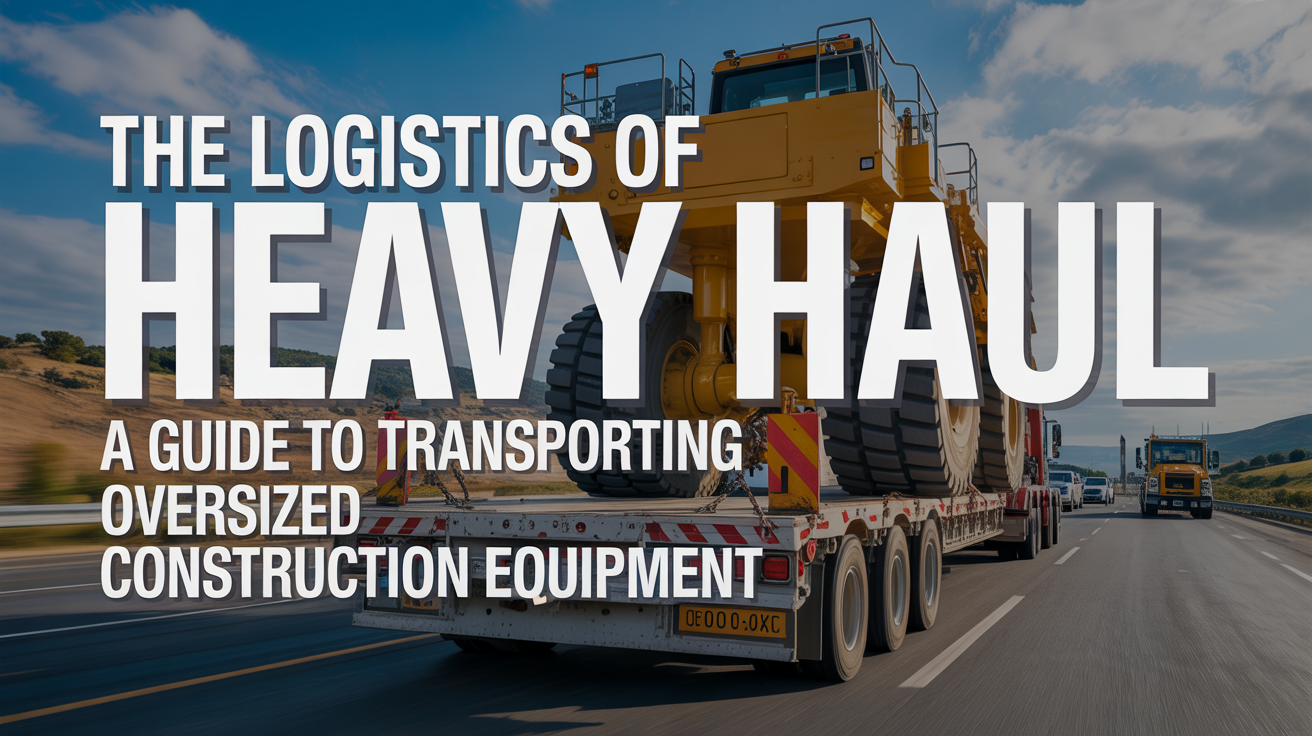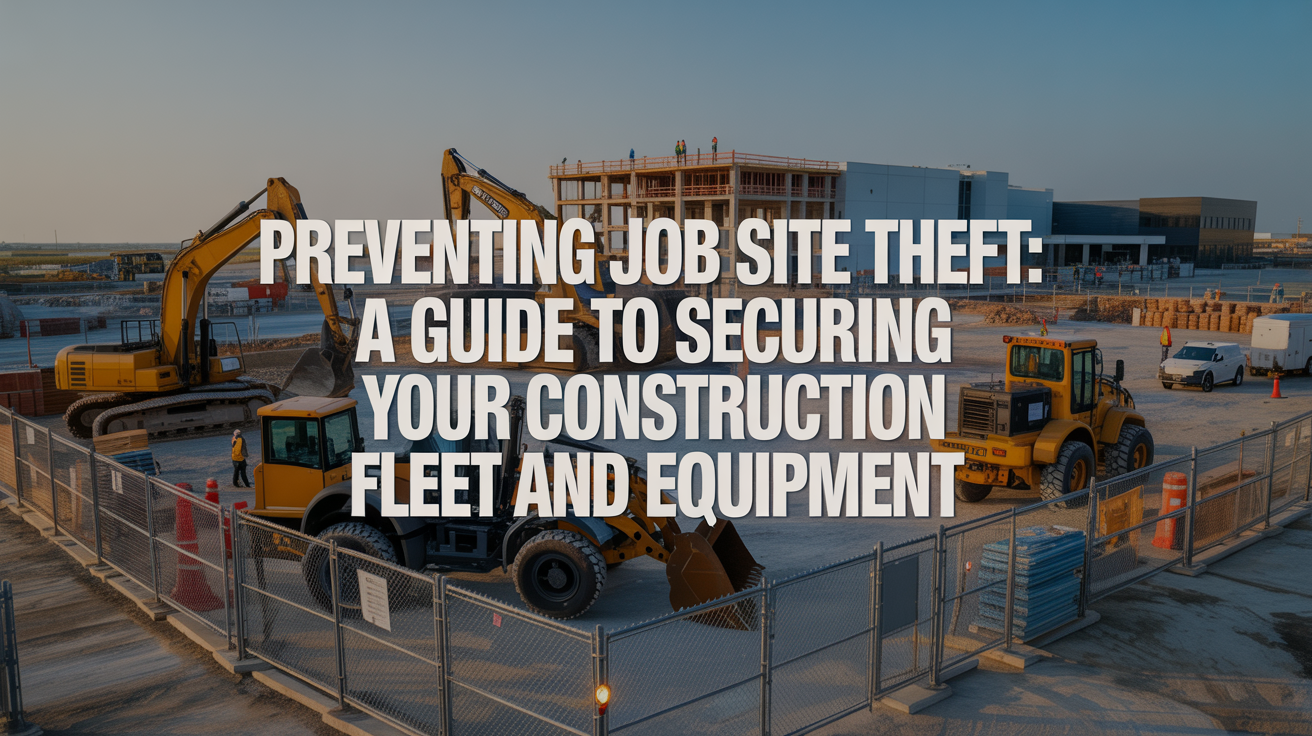The Logistics of Heavy Haul: A Guide to Transporting Oversized Construction Equipment
Introduction
Moving oversized construction equipment is no small feat-it’s a complex process that requires specialized logistics and meticulous planning. 🚧 Whether it’s an excavator, bulldozer, or crane, these machines are essential for large-scale projects but pose unique challenges when it comes to transportation. The sheer size and weight of such equipment demand expertise in route planning, regulatory compliance, and safety protocols. Without proper handling, delays, fines, and even accidents can occur.
This guide is designed for fleet managers, construction companies, and logistics providers who regularly deal with heavy hauls. These professionals need to understand what qualifies as oversized equipment-like bulldozers, cranes, and mining trucks-and why it requires special attention. Each piece of equipment has unique dimensions and weight limits that set it apart from standard freight, making transport a highly specialized task. 😊
In the sections ahead, we’ll explore key topics like regulatory requirements, choosing the right trailers, securing loads, and managing costs. By the end of this guide, you’ll have actionable insights into ensuring safe, efficient, and compliant heavy haul logistics. Let’s dive in!
Defining Oversized Construction Equipment
Oversized construction equipment typically includes machinery like excavators, bulldozers, cranes, and dump trucks. These items are classified as oversized based on their weight, length, width, or height exceeding standard legal limits. For example, in many regions, anything over 80,000 pounds or wider than 8.5 feet is considered oversized. Understanding these criteria is crucial because it determines the type of permits and vehicles needed for transport.
Examples of oversized equipment include massive crawler cranes used in wind turbine installations or mining haul trucks that can weigh over 300 tons. Proper classification ensures that logistics teams can plan appropriately, avoiding costly mistakes like using the wrong trailer or failing to secure the necessary permits. After all, knowing your cargo is the first step toward a successful haul! 🚛
Industry Applications: Where Heavy Haul Is Essential
Heavy haul logistics plays a vital role in industries like construction, mining, energy, and agriculture. In construction, transporting cranes and bulldozers is essential for building skyscrapers, bridges, and highways. Similarly, the mining sector relies on oversized equipment like haul trucks and drilling rigs to extract resources efficiently. Energy projects, such as wind farms and oil refineries, also depend on heavy hauls to move turbines and processing units.
For instance, consider a wind farm project where massive turbine blades need to be transported across state lines. These blades can stretch over 200 feet long, requiring meticulous planning to navigate tight turns and low-clearance bridges. Such real-world examples highlight how oversized transport is not just a logistical challenge but a critical component of project success. 💪
Choosing the Right Trailer and Transport Vehicle
When it comes to transporting oversized equipment, selecting the right trailer is crucial. Common options include flatbeds, lowboy trailers, and step decks. Flatbeds are versatile but may not accommodate extremely tall or heavy loads. Lowboy trailers, with their lower deck height, are ideal for heavy machinery like bulldozers and excavators. Step decks offer additional clearance and are great for equipment that exceeds standard height limits.
“Some oversized or overweight machinery may require a permit for transportation. If you are transporting a backhoe, dozer, dump truck or other large pieces of equipment, check your state’s requirements to see if a permit is necessary.”
-Equip Trucking
The choice of trailer depends on several factors, including the cargo’s size, weight, and height, as well as legal clearance limits on highways. For example, a lowboy trailer might be necessary to avoid hitting overhead structures like bridges. Choosing the wrong vehicle can lead to delays, fines, or even accidents, so careful consideration is key. 🚜
To minimize risks and costs, always assess the cargo’s specifications before selecting a trailer. Consult with experts if needed, and ensure the chosen vehicle meets all regulatory requirements. This proactive approach not only saves money but also ensures a smoother, safer transport process.
“The planned route should be mapped out and actually driven ahead of time. You want the shortest route possible, but a longer route may be necessary to avoid bridges with weight limits, low overpasses, and other restrictions.”
-Pile Buck
Permitting and Regulatory Requirements
Transporting oversized loads requires navigating a maze of permits and regulations. Federal and state laws dictate the maximum allowable dimensions and weights for vehicles on public roads. Permits are often required for loads exceeding these limits, and the process can vary significantly depending on the location. Some states have strict rules about escort vehicles, while others focus on route restrictions.
To determine if a permit is needed, logistics teams must evaluate the load’s dimensions and weight against local regulations. Once identified, they must submit detailed applications, including route maps and vehicle specifications. Failing to comply with these requirements can result in hefty fines or even the impounding of the equipment. 😬
“When choosing the right trailer or heavy hauler to transport your equipment, look for one with the right capacity to support your cargo. Remember to account for the weight of the trailer itself when calculating the total weight your vehicle will be hauling.”
-Equip Trucking
Common pitfalls include incorrect paperwork, misclassification of the load, and missing deadlines for permit approval. To avoid these issues, work with experienced logistics providers who understand the nuances of regulatory compliance. Staying organized and informed is the best way to keep your haul on track.
Effective Route Planning and Logistics Coordination
Route planning is one of the most critical aspects of heavy haul logistics. It involves mapping out the safest and most efficient path to avoid obstacles like low bridges, narrow roads, and weight-restricted highways. Seasonal closures, road construction, and traffic patterns must also be considered to prevent delays. Advanced mapping tools and GPS technology can help identify potential hazards before the journey begins.
“There should be at least four chains used. Two in the front corners and two in the back corners of the trailer.”
-Pile Buck
Coordination with local authorities is another key element. Escort vehicles may be required for particularly large or heavy loads, and scheduling these services in advance is essential. Effective communication between drivers, dispatchers, and escorts ensures smooth operations and minimizes downtime. With proper planning, even the most challenging hauls can be completed successfully. 🗺️
Safe Loading and Equipment Securement
Safe loading starts with understanding the equipment’s weight distribution and manufacturer guidelines. Before transport, inspect the machinery for any loose parts or fluid leaks that could cause issues during transit. Choosing the right trailer-one that can handle the equipment’s weight and dimensions-is equally important. Proper preparation reduces the risk of accidents and ensures compliance with safety standards.
“Make sure the equipment’s parking brake is engaged. Use wedges, cradles, chocks – whatever is appropriate – to secure the wheels.”
-Pile Buck
Securing the load involves using tie-downs, chains, binders, and chocks to prevent movement during transport. Industry best practices recommend at least four tie-down points for stability. Chains should be rated for the equipment’s weight, and binders must be tightened securely. Immobilization techniques, such as blocking and bracing, add an extra layer of safety. ⛓️
Risk mitigation is a shared responsibility among shippers, carriers, and drivers. Following regulatory standards, conducting regular inspections, and training staff on proper procedures are all essential steps. When everyone works together, the chances of a successful and incident-free transport increase significantly.
“The safety of the public is their greatest concern and responsibility. Heavy hauling increases the risk to the regular folks driving vehicles far smaller than an 18-wheeler.”
-Pile Buck
In-Transit Safety Monitoring and Adjustments
Monitoring cargo during transport is crucial for maintaining safety and efficiency. Modern technologies like GPS tracking allow logistics teams to monitor the vehicle’s location and speed in real-time. Drivers should follow checklists for routine inspections, and scheduled stops can help identify potential issues before they escalate.
Common challenges include shifting loads, mechanical breakdowns, and unexpected road conditions. Having emergency response protocols in place ensures quick action in case of incidents. For example, if a load shifts, the driver should pull over immediately to assess and correct the issue. Proactive measures like these help prevent accidents and ensure timely delivery. 🚨
“This industry requires careful planning, regulation adherence, and a safety focus. From understanding the types of heavy haul trucks available to obtaining the necessary permits and navigating challenges, many factors are at play when successfully transporting oversized freight.”
-Pangea Network
Delivery and Offloading Procedures
The final stage of heavy haul logistics is the delivery and offloading process. Site preparation is essential-ensure the destination has adequate space, stable ground, and the necessary equipment for unloading. Inspections should be conducted upon arrival to verify the condition of the cargo and address any issues promptly.
Safe equipment handover involves thorough documentation, including signed delivery receipts and condition reports. Follow-up communications with the client confirm satisfaction and provide an opportunity to address concerns. A smooth delivery process leaves a lasting impression and builds trust with customers. ✅
“If you are working with a heavy equipment hauling company, the driver will load and secure your equipment in accordance with DOT regulations.”
-Equip Trucking
Cost Considerations and Budgeting
Several factors influence the cost of heavy haul logistics, including the type of equipment, distance traveled, permits, escorts, and insurance. Heavier and larger loads typically require more resources, driving up expenses. Permits and escort vehicles can also add significant costs, especially for cross-state hauls.
To manage budgets effectively, negotiate transport contracts with multiple providers and compare quotes. Look for opportunities to bundle shipments or optimize routes to reduce costs. Investing in technology like fleet management software can improve efficiency and save money in the long run. 💰
“Make arrangements at both ends of the journey to safely load and unload your freight using appropriate equipment such as cranes or forklifts.”
-Pangea Network
Common Challenges and Solutions in Oversized Equipment Transport
Transporting oversized equipment comes with its share of challenges, from route issues and permit delays to mechanical breakdowns. These problems can lead to costly delays, damaged equipment, and strained customer relationships. However, with proper planning, many of these issues can be avoided.
Actionable solutions include conducting thorough route surveys, securing permits well in advance, and performing regular maintenance on transport vehicles. Partnering with experienced logistics providers and leveraging technology can also mitigate risks. By addressing potential problems proactively, you can ensure a smoother transport process. 🛠️
Innovations and Technology Shaping Heavy Haul Logistics
Technology is transforming heavy haul logistics, making it safer and more efficient. Telematics systems provide real-time data on vehicle performance, while fleet management software helps optimize routes and track assets. These innovations enable better decision-making and enhance operational efficiency.
Recent advancements include GPS asset tracking, predictive maintenance tools, and load sensors that monitor cargo stability. These technologies not only improve safety but also reduce costs by minimizing downtime and preventing accidents. As the industry continues to evolve, embracing innovation will be key to staying competitive. 🌟
Choosing the Right Heavy Haul Logistics Partner
Selecting the right logistics provider is critical for successful heavy hauls. Key factors to consider include the provider’s experience, safety record, licenses, and insurance coverage. A proven track record in handling oversized equipment is a strong indicator of reliability.
During the vetting process, ask questions about their fleet capabilities, permit acquisition process, and emergency response plans. Warning signs include vague answers, lack of transparency, or a history of safety violations. Building a long-term partnership with a trusted provider ensures consistent quality and access to expert advice.
To maximize the benefits of this partnership, leverage the provider’s expertise for operational success. Regular communication and feedback loops help refine processes and address any concerns promptly. Together, you can achieve seamless and efficient heavy haul logistics. 🤝
Frequently Asked Questions
1. What is considered oversized construction equipment?
Oversized construction equipment refers to machinery that exceeds standard legal limits for weight, length, width, or height. Examples include bulldozers, cranes, and mining trucks, which often require special permits and trailers for transport.
2. What permits are required for heavy haul transportation?
Permits for heavy haul transportation vary by location and load specifications. Typically, they include overweight and oversize permits, as well as approvals for escort vehicles and route-specific clearances.
3. How do you secure heavy machinery for transport?
Securing heavy machinery involves using chains, binders, tie-downs, and immobilization techniques like chocks and braces. At least four tie-down points are recommended for stability, and all equipment should meet regulatory standards.
4. What types of trailers are most commonly used?
Common trailers for heavy hauls include flatbeds, lowboys, and step decks. The choice depends on the cargo’s size, weight, and height, as well as legal clearance limits.
5. How much does it cost to transport oversized equipment?
Costs depend on factors like equipment type, distance, permits, escorts, and insurance. Cross-state hauls and heavier loads generally incur higher expenses.
Conclusion
Transporting oversized construction equipment is a complex yet manageable task with the right approach. Proper planning, regulatory compliance, and adherence to safety protocols are the cornerstones of effective heavy haul logistics. From selecting the right trailer to securing permits and monitoring cargo, every step matters in ensuring a successful haul.
Fleet managers and construction companies should take this guide as a starting point to refine their logistics strategies. Partnering with specialized providers and investing in ongoing training can make a significant difference. Stay current with regulations, embrace technological advancements, and consult experts for complex projects. Your next heavy haul could be your smoothest yet! 🚛✨



